Key takeaways:
- Long-term reconstruction planning should focus on restoring livelihoods and community relationships, not just physical structures.
- Post-conflict recovery is essential for building trust and emotional healing, which are crucial for sustainable peace.
- Effective planning requires inclusivity, adaptability, and a focus on sustainability to ensure community needs are met holistically.
- Empowering local individuals and fostering collaboration with community organizations leads to more impactful and meaningful recovery initiatives.
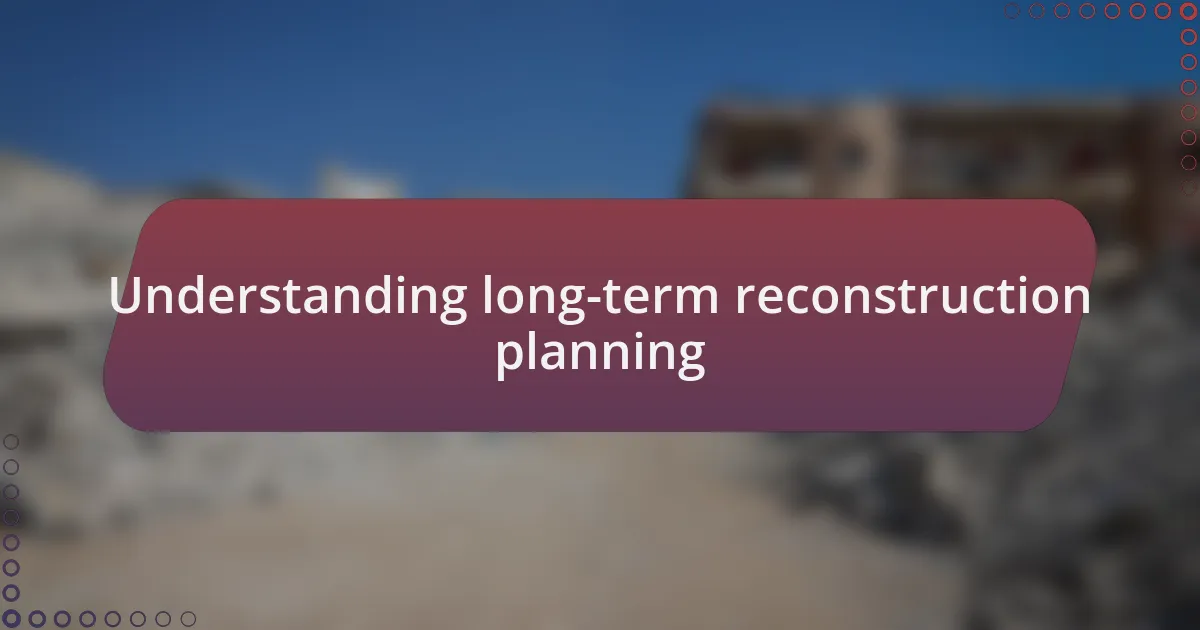
Understanding long-term reconstruction planning
Long-term reconstruction planning is more than just rebuilding structures; it’s about restoring livelihoods and fostering hope within communities. I remember visiting a region that had faced extensive damage, and seeing how people were not only eager to rebuild their homes but also their relationships and trust in each other. It made me wonder: how do we ensure that the plans we create truly reflect the needs and dreams of those affected?
One of the crucial aspects of effective reconstruction is understanding the context in which it takes place. When I observed a community struggling with both physical and psychological wounds, it struck me that without addressing the underlying social dynamics, the rebuilt structures would become mere shells. What if we viewed reconstruction as a holistic process—one that intertwines infrastructure with community healing?
In my experience, engaging the local population in the planning process is vital. I once participated in a workshop where community members shared their visions for the future, and the energy was palpable. It made me realize how essential it is to listen and incorporate these voices into our strategies. Could it be that the key to sustainable recovery lies in partnerships built on shared aspirations?
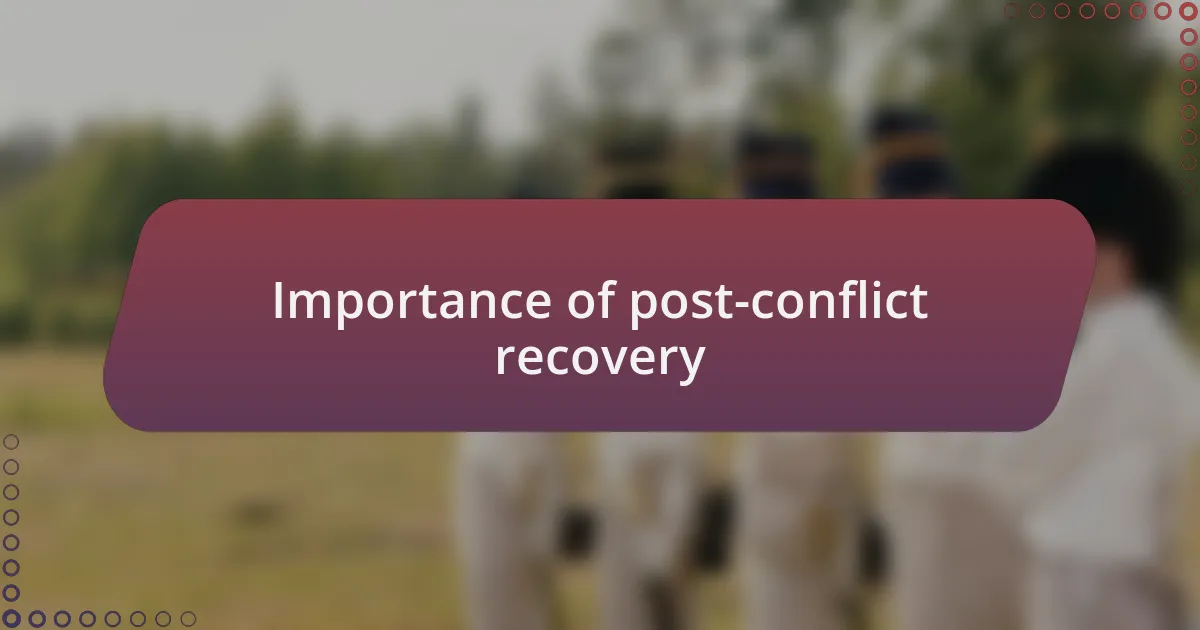
Importance of post-conflict recovery
Post-conflict recovery plays a pivotal role in rebuilding societies that have experienced violence and upheaval. I recall a time when I sat down with community elders who, despite their trauma, articulated a profound desire to forge a new identity for their village. Their words resonated with me: recovery is not just about tangible assets; it’s about healing collective wounds and reinforcing resilience among community members. How can we expect lasting peace if we overlook the emotional scars that linger?
The importance of post-conflict recovery cannot be overstated; it serves as a foundation for long-term stability. I remember a local leader sharing how, after the violence subsided, the first step was not the physical reconstruction of buildings but rather restoring trust among neighbors. It made me think: what if rebuilding relationships became as pivotal as rebuilding infrastructure? Such trust can foster cooperation and motivate people to actively participate in the reconstruction process.
I have witnessed communities that thrived following strategic recovery initiatives. In one case, a local initiative focused on vocational training empowered youth, turning their pain into purpose. It was inspiring to see how investing in human potential reshaped the community’s trajectory. Could the answer to sustainable recovery lie in nurturing not just the structures but also the hearts and minds of those affected?
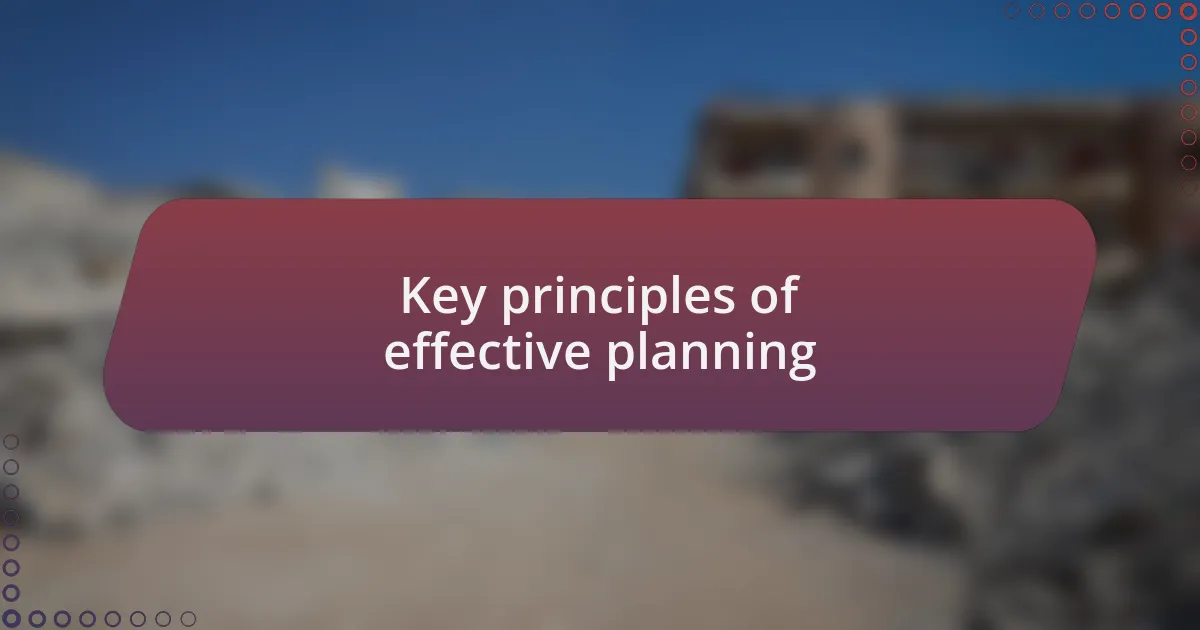
Key principles of effective planning
Effective planning in post-conflict recovery hinges on inclusivity. From my experience, bringing together diverse stakeholders—like community leaders, women’s groups, and former adversaries—creates a tapestry of voices that enriches the planning process. I remember joining a workshop where participants shared their experiences, leading to a more comprehensive understanding of the needs and desires within the community. Isn’t it fascinating how every perspective adds a new layer to our collective vision for recovery?
Another crucial principle is adaptability. In my work, I’ve found that plans must evolve in response to changing circumstances and emerging challenges. A project I was involved in focused on rebuilding infrastructure, but as we progressed, the community’s needs shifted toward education. Pivoting our resources to support local schools felt right, igniting a newfound hope among families. How often do we recognize that flexibility can be a strategy for success?
Lastly, sustainability is vital. I remember engaging with a community that initially aimed for quick fixes, but we soon realized that true recovery requires long-term investment. This insight led us to prioritize training local leaders who could continue initiatives after external support waned. How can we ensure that the seeds of recovery we plant today grow into a self-sustaining future?

Assessing community needs and resources
Understanding community needs and resources is the backbone of effective reconstruction planning. In one of my earlier projects, I conducted a series of workshops to assess the vital needs of a community post-conflict. What struck me was how people turned up, eager to voice their thoughts. Their stories, often tinged with loss yet filled with hope, gave me a nuanced picture of what they truly desired—jobs, education, and healthcare.
I find that resource mapping is equally essential in this process. During one assessment, we mapped out local resources like skills and materials, which revealed untapped potential. It was inspiring to see how community members had the ability and willingness to contribute; one artisan had a treasure trove of skills that, when paired with community needs, led to initiating a local craft market. Isn’t it incredible how resourcefulness often lies just beneath the surface, waiting to be harnessed?
Moreover, direct engagement with community members can unveil surprising insights. In a town I worked with, I learned that the youth felt disconnected from the rebuilding efforts, despite their enthusiasm. By facilitating open forums that included their perspectives, we were able to integrate their ideas into our planning. It made me realize that addressing needs isn’t just about the tangible; it’s also about fostering a sense of belonging and ownership in the recovery journey. How can we truly rebuild a community if we overlook the voices that are often the most vibrant?
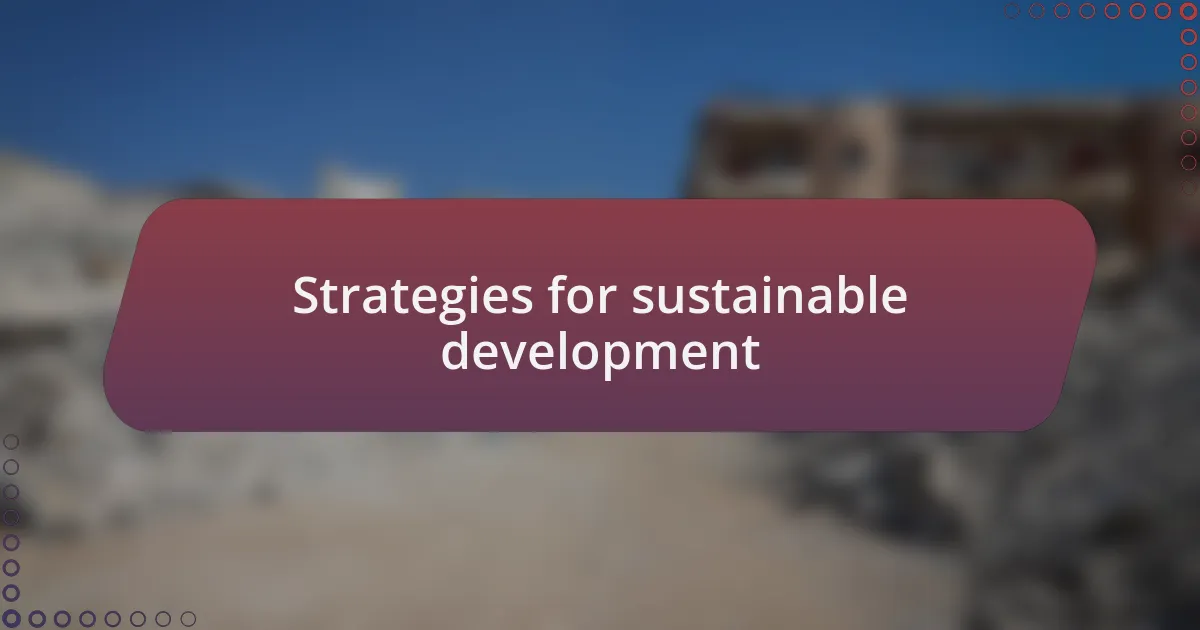
Strategies for sustainable development
One effective strategy for sustainable development is integrating local economic initiatives that empower individuals. During a project in a post-conflict area, I witnessed the transformation that can occur when local farmers are provided with access to training and resources. By teaching them sustainable farming techniques, not only did we improve their crop yields, but we also cultivated a sense of pride and ownership within the community. How often do we overlook the potential that lies in empowering individuals to become the architects of their own prosperity?
Another approach is establishing educational programs tailored to the needs of the community. I recall a workshop where local educators shared their vision for a skills training center aimed at helping youth develop marketable skills. This initiative not only addressed youth unemployment but also fostered a sense of hope and direction. What could be more powerful than equipping the next generation with the tools they need to thrive?
Lastly, collaboration with local organizations can amplify the impact of development efforts. In one particular instance, I partnered with a grassroots NGO that had deep ties to the community. By leveraging their knowledge and relationships, we were able to implement programs that resonated with the people’s values and traditions. It became clear to me that sustainable development isn’t merely about funding; it’s about crafting solutions that honor the unique narratives of the communities we aim to serve. Isn’t it fascinating how collaboration can unleash the collective power of a community?
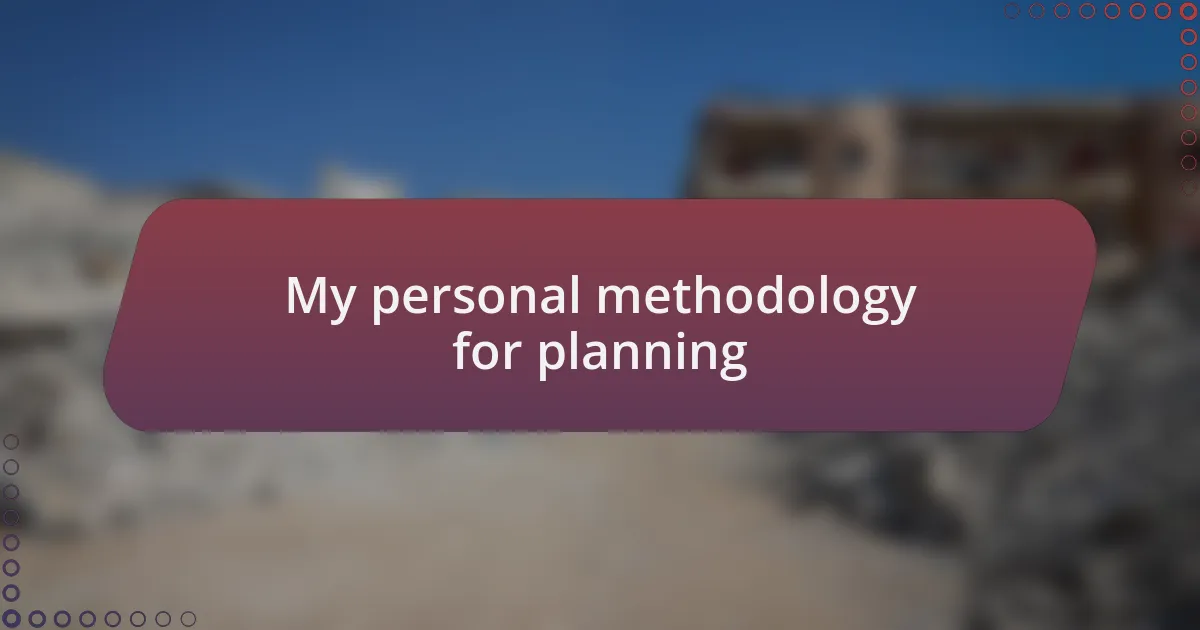
My personal methodology for planning
When it comes to my personal methodology for planning, I always start by conducting thorough community assessments. I recall a time in a conflict-affected village where I spent weeks just listening. It was during those conversations that I truly grasped the community’s needs, hopes, and apprehensions. How often do we rush into planning without understanding the heartbeat of a community? This foundational step allows me to tailor initiatives to fit the unique context of each project.
I also prioritize flexibility in my planning processes. I’ve learned that rigid plans can often miss the mark when realities on the ground shift. In one project, we began with a set timeline, but as we rolled out programs, unforeseen challenges arose. Rather than push through with the original plan, we adapted. I believe it’s crucial to remain open to feedback and willing to pivot. Isn’t that the essence of effective recovery – the ability to respond dynamically to emerging needs?
Moreover, I incorporate metrics for success that resonate with the community’s values. For instance, while evaluating progress, I focus not solely on quantitative data but also on the stories and testimonies from individuals impacted by our work. During a follow-up visit to a community garden project, I was moved to hear from a local woman who found her voice through participating. Her story reinforced my belief that success is not just numbers but real human experiences. How can we truly measure impact if we don’t celebrate these personal victories?
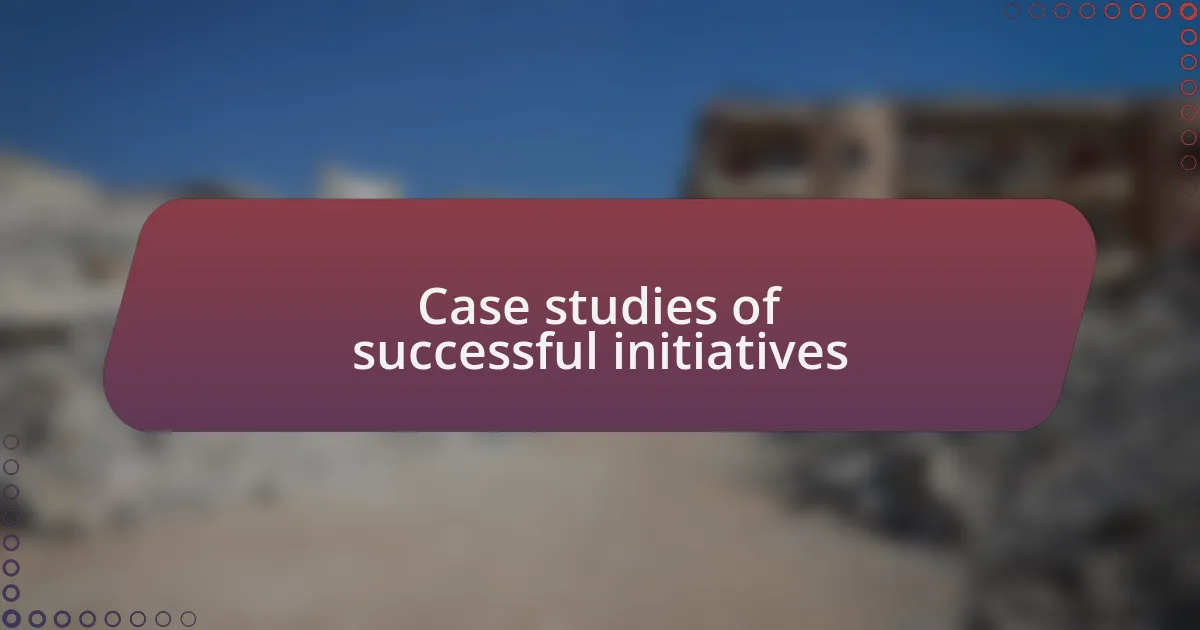
Case studies of successful initiatives
One notable case study is the rebuilding initiative in a conflict-affected town in Eastern Europe. Here, local leaders engaged the community in creating a shared vision for their futures. I remember visiting the area shortly after the project’s inception; residents expressed a renewed sense of hope as they participated in decision-making processes. Isn’t it remarkable how empowering individuals can transform mere reconstruction into a collaborative journey of healing?
Another compelling example comes from a project in the Middle East, where a focus on education proved to be pivotal. By establishing community schools that emphasized inclusive curricula, we saw an increase in enrollment and engagement among children. During a visit, a young girl’s enthusiasm was palpable as she shared her dream of becoming a teacher. Isn’t it inspiring to witness how one initiative can ignite aspirations for an entire generation?
Finally, the initiative in a rural African community showed the power of integrating economic recovery with social cohesion. By promoting local co-operatives, we facilitated job creation while rebuilding trust among residents who had previously been divided. I vividly recall the celebration during their first market day, where people from varying backgrounds worked side by side, rekindling relationships that had been strained. Doesn’t that highlight the beautiful complexity of recovery – where economic growth and social unity go hand in hand?